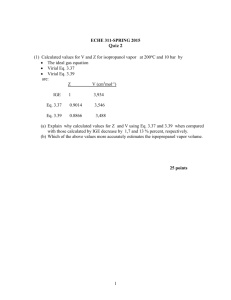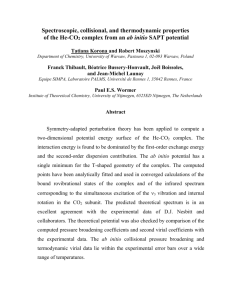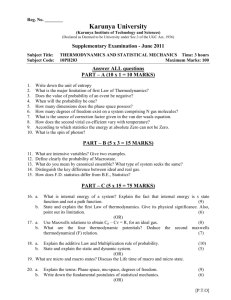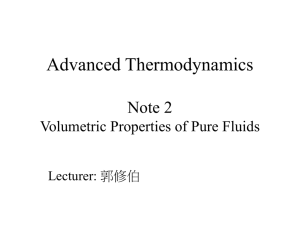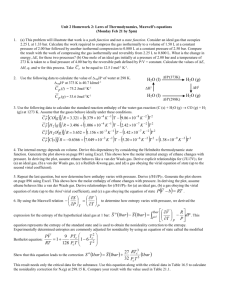Generalized Correlations for Gasses (Lee
advertisement
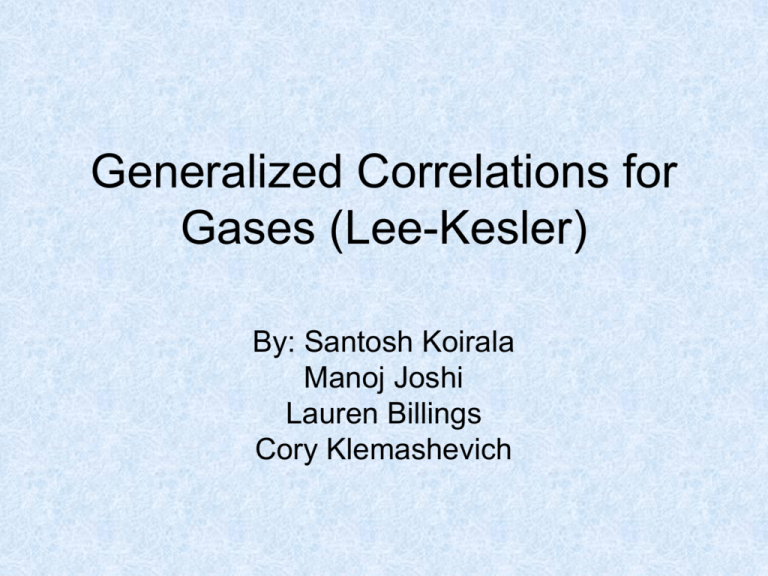
Generalized Correlations for Gases (Lee-Kesler) By: Santosh Koirala Manoj Joshi Lauren Billings Cory Klemashevich The Generalized Correlation for Gases • The generalized Pitzer’s correlation is a three-parameter corresponding states method for estimating thermodynamic properties of pure, nonpolar fluids . For the compressibility factor Z, it takes the form Z = Z0 + ω Z1 where, Z0 = Compressibility factor for fluids of nearly spherical molecules, ω = Pitzer's acentric factor, and Z1 = Corrects for nonspherical intermolecular forces. • Appendix E provides values of Z0 and Z1 (Lee-Kessler correlations), from which Z can be calculated and, hence, the molar volume can be computed. Virial equations The Virial equation (up to the second Virial coefficient) provides an approximation of Z and the equation is: BP Z 1 RT 0 1 ˆ B B B BPc ˆ B RTc 0.422 B 0.083 1.6 Tr Bˆ Pr Z 1 Tr 0 0.172 B 0.139 4.2 Tr 1 Cont…… The virial equation (up to the Third coefficient) also provides an approximation of Z. Such virial equation is: ˆ B 0 B1 B B C Z 1 2 V V ˆB BPc RTc 2 c 2 2 c CP ˆ C RT 2 ˆBP Pr r ˆ Z 1 C Tr Z Tr Z B 0 0.422 0.083 Tr1.6 0.172 B 0.139 Tr4.2 Cˆ C 0 C 1 1 0.2432 0.00313 C 0.01407 Tr Tr10.5 0 0.05539 .00242 C 0.02676 10.5 2.7 Tr Tr 1 Example Problem Determine the molar volume of n-butane at 510 K and 25 bar by each of the following: a) The ideal-gas equation, b) The generalized compressibility-factor correlation, c) Generalized correlation for B̂using eq. 3.61, d) Equation 3.68 the third virial coefficient equation. a A. By the Ideal Gas equation: RT (83.14)(510) 3 1 V 1,696.1cm mol P 25 B. From the values of Tc and Pc given in Table B.1 of App. B Z Z Z 0.873 0 1 ZRT (.873)(83.14)(510) 3 1 V 1,480.7cm mol P 25 C. Using the Second Virial Equation P T Pc Tc Pr Tr ω B0 B1 B̂ Z R V 25bar 510K 37.96bar 425.1K 0.658587987 1.199717713 0.2 -0.232344991 0.058943546 -0.220556282 0.878925087 83.14cm3bar/molK 1490.706167cm3/mol Here, Excel was used to calculate the volume using second virial coefficient equation. BP Z 1 RT BP c ˆ B RT c Bˆ P r Z 1 Tr Bˆ B 0 B 1 B 0 B 1 0 . 422 0 . 083 T r1 . 6 0 . 172 0 . 139 T r4 .2 D. Using Second and Third Virial coefficient P T Pc Tc Pr Tr ω B0 B1 C0 C1 Ĉ R V 25bar 510K 37.96bar 425.1K 0.658587987 1.199717713 0.2 -0.232344991 0.058943546 -0.220556282 0.03312865 0.006760336 0.034480717 83.14cm3bar/molK 1484.438039cm3/mol B C 2 V V ˆ BPc B RTc Z 1 Z Z (Guess) (Calculated) 1 0.889316 0.889316 0.876994 0.876994 0.875453 0.875453 0.875258 Ĉ 0.875258 0.875233 0.875233 0.87523 0.87523 0.875229 0.875229 0.875229 0.875229 0.875229 0.875229 0.875229 0.875229 0.875229 0.875229 0.875229 0.875229 0.875229 0.875229 0.875229 0.875229 0.875229 0.875229 0.875229 2 ˆ CPc C R 2Tc2 ˆP B Pr r ˆ Z 1 C Tr Z Tr Z 2 ˆ B 0 B1 B B 0 0.083 0.422 Tr1.6 B1 0.139 0.172 Tr4.2 ˆ C 0 C 1 C C 0 0.01407 0.2432 0.00313 Tr Tr10.5 C 1 0.02676 0.05539 .00242 Tr2.7 Tr10.5 This is the third coefficient virial equation for the same problem. Again Excel was used to obtain the solution. The solution is again very close to the value obtained by the Lee-Kesler method. Where the Virial Equation Applies • • This graph shows the difference obtained for the Z0 value for the Lee/Kesler correlation vs. the virial coefficient equation. The second coefficient virial equation works at low pressures where Z is a linear function. It is used when an approximation of a non ideal gas is needed, but at non extreme temperatures and pressures. The third virial coefficient equation provides another correction to the virial equation.
